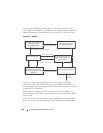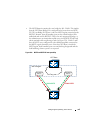
732 Configuring the Spanning Tree Protocol
The VLAN 1 STP instance of SW1 and SW2 are joined with the STP
instance running in SW3. VLANs 2 and 3 consider the path across SW3 as
another segment linking SW1 and SW2, and their SSTP information is
multicast across SW3.
The bridge priority of SW1 and SW2 for VLAN1 instance is 32769 (bridge
priority + VLAN identifier).
The bridge priority of SW3 is 32768, per the IEEE 802.w standard.
SW3 is selected as Root Bridge for the VLAN1 instance that is CST, and SW1
is selected as Root Bridge for VLAN2 and VLAN3 (based on the low MAC
address of SW1).
Interoperability with MSTP
RSTP-PV runs an individual RSTP instance for each VLAN. MSTP maps
VLANs to MSTIs, so one-to-one mapping between VLAN and STP instance
is not possible.
MSTP runs multiple MSTIs inside a region and maps them to the CIST on
the border ports. The interoperability model must ensure that internal MSTIs
are aware of changes to any of the RSTP-PV trees. Therefore, the simplest way
to ensure the correct behavior is to join ALL RSTP-PV trees to the CST.
Connecting RSTP-PV trees to the CST ensures that changes in any of the
RSTP-PV STP instances will affect the CST and all MSTIs. This approach
ensures that no changes go unnoticed and no black holes occur in a single
VLAN. As with IEEE STP, every tree in the RSTP-PV domain views the
MSTP regions as virtual bridges with multiple boundary ports. A topology
change in any of RSTP-PV trees will affect the CST and propogate through
every MSTI instance in all MSTP regions. This behavior, consequently, makes
the MSTP topology less stable.
The MSTP implementation simulates RSTP-PV by replicating CIST BPDUs
on the link facing the RSTP-PV domain and sending those BPDUs on ALL
VLANs active on the trunk. The MSTP switch processes IEEE STP VLAN 1
BPDUs received from the RSTP-PV domain using the CIST instance. The
RSTP-PV+ domain interprets the MSTP domain as an RSTP-PV bridge with
all per-VLAN instances claiming the CIST Root as the root of their individual
spanning tree. For the common STP Root elected between MSTP and RSTP-
PV, two options are possible:


















